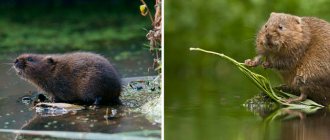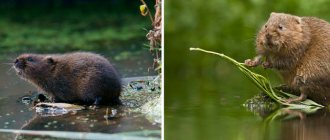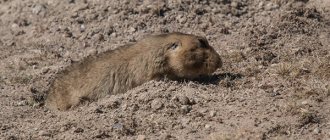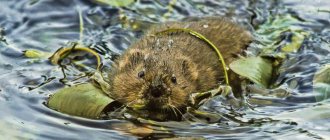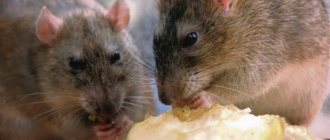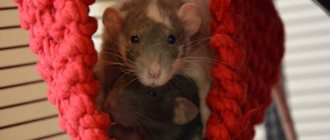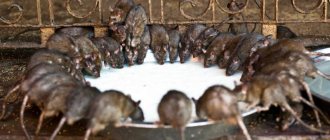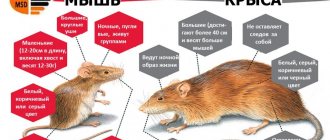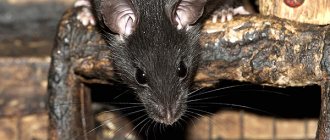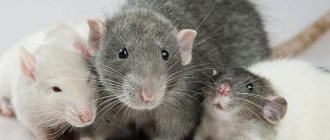Everyone needs to know what a rat looks like. Everyone needs to know what a rat looks like, since this creature can not only cause material damage to people, but also threatens to harm their health. The thing is that quite often rats carry a variety of infectious diseases. Thus, by detecting a rat in a timely manner, you can take effective measures to combat them, which will help avoid the negative consequences of living together.
For information
Rats belong to the class of mammals, more precisely, to the order of rodents and the family of mice. These rodents can be found in almost every corner of the planet. They even exist on islands that are very far from the mainland. The rat is the largest rodent of the mouse family, but they have significant differences in the anatomical structure of the body. They have an elongated body, a sharp muzzle, voluminous eyes and ears, and sparse hairs on their scaly tail. The skull consists of 6 unpaired and 11 paired bones. It is also divided into two sections: facial and cerebral.
By detecting a rat in a timely manner, you can take effective measures to combat them, which will help avoid the negative consequences of living together
Small rat
The taxonomy of the rat does not end there; its continuation is the small rat. The Pacific or Polynesian rodent is found in the Philippines, New Zealand, as well as the countries of Asia and New Guinea. The habitat of the animal is forest and forest-steppe zones.
Depending on the distribution area, the length of the animal’s body varies. The animals inhabiting the mainland of the continent reach up to 15 cm, small rats living on the islands do not grow more than 11 cm. The weight of the animal is also small: only from 40 to 80 g. The fur of a small rodent on the back is brown, in the abdomen - light tones Its distinctive characteristics also include a pointed muzzle, large ears and short legs. The tail has a length commensurate with the size of the body, and is covered with scaly rings.
The diet of the small rat is very diverse, it includes: seeds, fruits and parts of plants, as well as insects, spiders, bird eggs and tiny chicks.
Small rats reproduce throughout the year; the reproduction process becomes especially active in the summer.
Interesting!
Over the course of a year, one adult female produces no more than 4 litters, each of which contains 5-9 individuals. Newborn rat pups are constantly protected and controlled by the female, and she also feeds them milk for a month.
Decorative pets
Characteristics of appearance
You can often find types of rats such as black and gray. These rodents are classified as synanthropic species. This means that they prefer to live and breed near people. Some representatives live mainly in warm countries.
The following external features can be distinguished that make it possible to distinguish rats from other animals:
- A long tail. The tail of rats is much larger than that of mice. As a rule, the length of the body almost completely coincides with the length of the tail itself. Mice have a small tail with fur on its surface. Rats have a rather thick and strong tail. He's practically bald.
- The coat can be black, gray or brown. Sometimes you can find individuals with a variety of colors.
- A distinctive feature is the shape and length of the muzzle. Mice have a small triangular muzzle. In rats, the muzzle is quite voluminous and elongated forward.
- Body length can vary from 8 to 30 cm. It is clear that this indicator is not the norm, and in life you can meet rats with a much longer body length. It all depends on body parameters, type, living conditions.
- The toes on the paws are very pronounced. The fingers have claws that facilitate the process of digging and climbing.
Rats can move quickly and easily on vertical surfaces. The body is very strong and springy, which allows the rat to jump up to 80 cm in height. In some cases, rodents can jump up to 2 m in height. Thanks to their speed of movement and high level of endurance, rats can cover a distance of almost 50 km per day.
Rats belong to the class of mammals, more precisely, to the order of rodents and the family of mice
Fighting rats is quite difficult and it is simply impossible to destroy them. If there is a decline in the population, then these animals immediately begin to reproduce very actively. As a result, the number of rats increases significantly, and newborn rats practically do not die at a young age.
Cubs
Little rats become attractive 2 weeks after their birth. They are born absolutely helpless - naked, deaf, blind, with undeveloped limbs and a short tail. Body weight does not exceed 6 g. Females actively suck nutritious milk and develop rapidly every day.
Already on the second day, down begins to appear on the back, finally covering the body after a week. The ears open after 5 days, the babies begin to hear rustling and squeaking of the female. After 2 weeks, the eyes appear. From this moment, the cubs begin to crawl out of the nest and explore their surroundings.
At 20 days, the formation of the body ends - the correct proportions, claws on the paws are clearly visible, and nipples appear in females. The molars begin to grow, the animals begin to feed on their own, eating all the food typical for adult rodents.
25 days after birth, the pups become similar to adults, but are smaller in size. The tail grows slowly. The development of the young generation finally ends at 12 months of age.
After a year, a young rat can produce healthy, strong offspring, although the ability to fertilize develops already by 1.5 months. The baby rat in the photo at different periods of his growing up is shown below.
Rats at different stages of life
On a note!
Already at 9 days of life, the size of the baby rats is equal to the dimensions of an adult mouse. You can distinguish a rat and a mouse by their unformed proportions and behavior. Little rats are not yet familiar with the feeling of fear of people.
What are the types?
As mentioned above, in our climate you can most often find a black or gray rat. These rats differ from each other not only in coat color, but also in certain anatomical characteristics.
The gray rat is also commonly called pasyuk. This type of rat can be found almost everywhere. The only thing is that they cannot exist in polar latitudes. You can see exactly what the pasyuk looks like not only when settling near people, but also in natural conditions. If we consider southern latitudes, then these rodents can be observed near water sources in burrows. In temperate climates during the winter cold, rats prefer to live next to humans. For Pasyuk, it is preferable to live in rural areas where there are large pets. He settles next to them and eats their food. Rats can even exist in cities. In this case, they settle in the basements of various buildings and where there is a garbage disposal nearby, since garbage is the main source of their food.
These rodents can be found in almost every corner of the planet
The gray rat's fur is much coarser in structure. The fur on the belly is slightly lighter than on the back. Among the entire mass of fur, white hairs are very clearly visible. Pasyuks also have a slightly blunted muzzle. The length of the tail in rare cases can exceed 80% of the length of the entire body. This species of rat is omnivorous. They very quickly adapt to various toxic substances, that is, to poisons. This leads to the fact that they simply stop responding to them. These rodents manage to swim very well. They can stay in water for several hours.
As for size, the black rat has slightly smaller body parameters compared to the gray rat. Even in warm conditions, black rats settle near people. The black rat's muzzle has a slightly narrow shape. The tail itself is slightly longer than the body. Under natural conditions, black rats tend to lead a semi-arboreal lifestyle. This means that the creature settles in branches and hollows of trees. If pasyuks in the city live in basements, then black rats can live even on the upper floors.
In case of danger, gray rats begin to attack, while black rats consider it best to simply run away. The spread of these species is explained by the fact that humans have water transport at their disposal. They got onto the ships independently or with cargo. These rodents permanently live on board sea and even river vessels. Black rats are often more common here. Once you encounter this parasite, you can easily remember it. Most of these animals become very accustomed to the presence of humans and therefore do not always hide when meeting a person.
The rat is the largest rodent of the mouse family.
Black-tailed rat
The black-tailed rat is another species of the mouse family, the distinctive feature of which is its tail covered with thick hair. Animals are common in New Guinea and Northern Australia. Their habitat is the coastal zone of rivers and other bodies of water, where after the surf, rodents collect food thrown out by the waves. The animals hide in hollows or between thick branches of trees, where females make nests for future offspring. The presence of fur is a distinctive feature of born rat pups. In addition, they mature and grow much faster than their relatives.
Structure of teeth
Teeth are perhaps one of the most distinctive features of a rat, preventing it from being confused with a mouse.
Both the lower and upper jaws have two long incisors. In their sharpening, cutters are very similar to a chisel. On their front side there is very durable enamel. There is no enamel on the back side, and therefore they are constantly worn away, taking on the shape of a chisel. In the oral cavity of these rodents there is a diastema, which is a gap in the jaws in which teeth are completely absent. These voids are located between the incisors and molars. Incisors do not have a root system, which is why they grow continuously. This feature of the teeth completely answers the question of why rats constantly chew something. The thing is that the incisors grow continuously and if they are not ground down, they will grow so much that the rodent will not be able to fully close its mouth.
When living in a natural environment, that is, in nature, rats use their incisors to gnaw through various roots, branches and plants
There are different varieties of rats, and if we take into account the domestic type, they need to constantly put hard objects in the cage with which they can grind down their incisors. These rodents have very strong teeth. This is confirmed by the fact that they can cope with hard materials such as cement, wood, stone and some types of steel. When living in a natural environment, that is, in nature, rats use their incisors to gnaw through various roots, branches and plants.
As for the molars, they are located very close to each other and form an entire row. Their main task is to grind food. These teeth have a characteristic flat and slightly cusped surface.
Harm to human farmer
IMPORTANT! Any species of rodents can be carriers of dangerous infectious diseases (leptospirosis, plague, rabies).
Farmers' losses from rats have always been impressive:
- Both types of rodents damage agricultural crops at any stage of plant development (especially in conditions of shortage of other food).
- Feeding on tree bark threatens the viability of gardens.
- Adults hunt young poultry and feast on eggs with pleasure.
- They physically spoil the harvest of grains, vegetables, fruits, and contaminate stored food with excrement (they eat any type of food suitable for humans).
- Gnawing through containers increases food losses during transportation and storage.
Statistics on the dangers of rats for the economies of countries:
- India – 750 million rupees.
- USA – 300 million annually.
- Denmark - 10 million crowns.
- Great Britain - 15 million f.s.
Body structure
Experts say that street rats have the ability to adapt and survive in almost any environment. But despite all this, they have very poor eyesight. This is explained by the structure of the lens. The structure of the lens makes it possible to see everything that surrounds it at an angle of 16º. To see much more, the rat is forced to constantly turn its head. They see almost everything that surrounds them in gray. They also have the ability to see the bluish-green part of the light spectrum. In red they see complete darkness.
Rats have very well developed senses of smell. Despite this, animals are not able to use this feature over long distances. This characteristic of the organism can be explained by the fact that evolution and natural selection determined it this way. The life of these animals occurs in such conditions that they simply do not need to have a higher sense. Despite this, at short distances, rats are very good at distinguishing all odors. They constantly examine each other using their sense of smell to understand who is nearby - their own or someone else's.
There are different types of rats
A certain feature is observed in the structure of the hearing organs. Rats can hear sounds even at frequencies around 40,000 Hz. Animals react very quickly even to the quietest noises. A very interesting fact is that pure sounds are not perceived by their ears at all.
Communication occurs with the help of a characteristic squeak. Rats have the best developed sense of touch. This has been confirmed through special studies. Special vibrissae act as organs of touch - these are small sensitive hairs. There are a lot of these hairs on the face.
Rodents have a very clear understanding of the tastes of food. In this respect they are not at all different from other existing species of mammals. The ability to distinguish taste is explained by the presence of small filiform papillae on the surface of the tongue. At the top they are covered with a special keratinized epithelium. This makes it possible to better retain food in the mouth. Rats have very well developed salivary glands, and the parotid, submandibular and sublingual glands are considered the most developed. The functioning of these glands ensures the production of saliva in the oral cavity, which is necessary for digesting food and wetting dust particles. Rodents need to wet the dust with saliva when they are setting up their home, or rather digging a hole.
These rodents have very strong teeth
Rat head
The head of a rodent has the following features:
- quite large in size;
- elongated shape;
- pointed nose;
- rounded miniature ears;
- small eyes.
The rat's head has two parts - front and back. It is separated from the rat's body by the neck. The rodent's ears are shaped like a movable shell. The auditory canal runs through its base along the temporal bone.
Digestive and genitourinary system
The intestines have the same type of structure as those of other mammals on the planet. It has two sections - the small and large intestines, which pass into the rectum, ending in the anus. The length of the small intestine is significantly greater than the length of the large intestine. The abdomen of rats contains other organs, such as the liver. The weight of the liver in an adult reaches 12 g, which is significantly more than the weight of the brain. The liver is responsible for the process of secreting bile, since there is no other organ in the body that would deal with this process, that is, there is no gallbladder.
The pancreas plays a very important role in the life of a rat. It produces some enzymes necessary for a complete digestion process. The urinary system consists of the kidneys, ureters, bladder and urethra. Experts say that rat urine has a rather unusual composition. In addition to the characteristic metabolic products, ferromones are present in the urine. With their help, rats have the opportunity to obtain information regarding the health and situation of other rodents. Inside the abdomen of rats are organs such as the spleen, as well as the adrenal glands. These animals have very well developed reproductive organs. They have clearly defined characteristics of gender.
Rats have very well developed senses of smell.
It should be noted that systems such as blood circulation and respiration are of great importance for the life of rats. When inhaled, air initially enters the nose, then goes through the trachea and, therefore, enters the lungs. The rodent trachea consists of 30 cartilaginous rings. It has a bifurcation at the end, and then smoothly passes into the bronchi. The lungs are located in the chest area and occupy more than half of the space there. The left lung consists of only one lobe. The right lung consists of four lobes. If the rat is completely healthy and the respiratory system is fully functioning, then it can take about 150 inhalations and exhalations over the course of one minute.
The main task of the chest is to protect the most important organ, that is, the heart. The heart of an adult weighs no less than 1.5 g. The heart muscle in rats has a fairly dense, elastic structure. Heart muscle tissue recovers very quickly. If laboratory tests are necessary, blood is taken directly from the heart. These rodents have a very high heart rate. It ranges from 300 to 600 beats per minute. The amount of blood in adult rats is 15-17 ml. The blood contains a large amount of hemoglobin, or rather 16g/100ml.
The chest contains not only the heart and lungs, but also the internal secretion organs. These are glands such as the goiter, paired thyroid glands, and two parathyroid glands. These glands play an important role in the complete metabolic process necessary for normal life.
Rat Standard
One of the most popular varieties of decorative rats is the standard rat. The animal has the most harmonious build: it has a massive elongated body, shiny short hair, moderately wide ears and a long tail covered with hair. It is similar in weight and body size to its gray counterpart. Males are larger but less energetic.
On a note!
When asking the question whether a rat is an animal or not, one can accurately answer that it is the most perfect animal, which is distinguished not only by physical strength and endurance, but also by intelligence. Thus, standard-type rats do not attack humans even when handled awkwardly, because they get used to their owner.
Pets
It turns out that there are people who take great pleasure in dealing with rats and even saving them from harm. One such rat-loving community is called Felis Lynx (rats). “What happened to Pasyuk?” - This is one of the topics on their forums on the Internet. A community has been created to help everyone who wants to have a little rat at home with advice, because raising a little rat is not so easy. There are people in the community who raise exclusively domesticated animals, which are more sociable, not at all aggressive, like little living lumps that require love and care. But there are people who undertake to release wild rat pups. Pasyuki also get used to captivity, with difficulty, but they are tamed, respond to the name, and can even allow themselves to be played with. But for example, males have a harder time tolerating the appearance of a stranger in their cage, they can even bite it to death, and at first they have difficulty with cleaning the cage or food bowl.
Behavior
The gray pasyuk rat is a social animal; in nature it lives in groups; it rarely tolerates loneliness. One family can occupy a territory of up to 2 square km, which is carefully marked and guarded. But if necessary, called “food production,” the boundaries of the territory are easily expanded. A family can have from 100 to 2000 members. Among male rats, like other mammals, there is a strict hierarchy consisting in the selection of females for prolongation of the family. But there is no help and protection for each other here. Rats are always for themselves. They are very smart, have a good memory, if everything suits them, they are not aggressive, but they know how to stand up for themselves. Rats fight excellently, not only with their relatives, but also with large animals. Previously, English sirs even staged spectacular rat-dog fights, which, fortunately, have already been banned.
Where did they come from
12 thousand years ago, gray rats lived only in East Asia. The Ice Age left them a small space, where Eastern China is now located.
With warming, the pasyuk rat slowly occupied Altai, Primorye, Transbaikalia and southern China. But large-scale migrations occurred with the development of navigation. It was on ships that the tailed animals moved to Europe, Australia, Africa, America, populating all populated areas and suitable natural spaces. Now they are not found only in Antarctica and the Arctic. Since they arrived in new places on ships, even a certain John Berkenhout, an English naturalist, dubbed them Norwegian rats, thinking that schooners and boats came to England from there, and not knowing that at that time there were not a single rat in Norway. Despite the error, the species name Rattus norvegicus still exists today.
